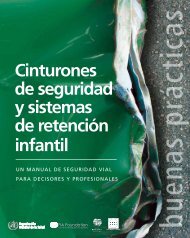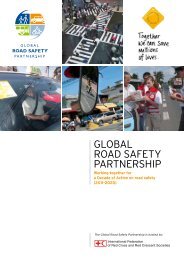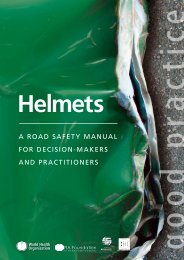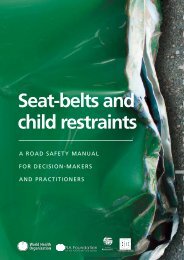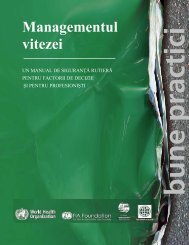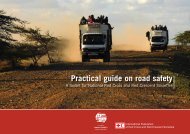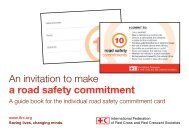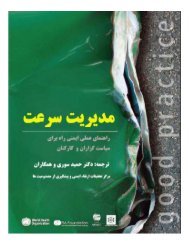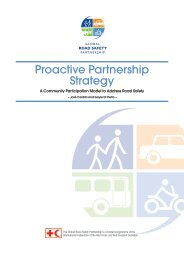How to design and implement a drinking and driving programme pdf ...
How to design and implement a drinking and driving programme pdf ...
How to design and implement a drinking and driving programme pdf ...
You also want an ePaper? Increase the reach of your titles
YUMPU automatically turns print PDFs into web optimized ePapers that Google loves.
Module 3: <strong>How</strong> <strong>to</strong> <strong>design</strong> <strong>and</strong> <strong>implement</strong> a <strong>drinking</strong> <strong>and</strong> <strong>driving</strong> <strong>programme</strong><br />
1. Diagnostic testing<br />
The first step in developing campaign messages is <strong>to</strong> assemble a small group of individuals<br />
representing your main target group. Ideally these individuals will have been<br />
charged with a <strong>drinking</strong> <strong>and</strong> <strong>driving</strong> offence. The goal of discussions is <strong>to</strong>:<br />
• identify <strong>and</strong> underst<strong>and</strong> why these individuals drink <strong>and</strong> drive (e.g. they don’t<br />
underst<strong>and</strong> the road safety risks involved, they are not familiar with the effect of alcohol<br />
on their ability <strong>to</strong> drive safely, they don’t think they will be caught);<br />
• underst<strong>and</strong> the motivations that might be used <strong>to</strong> change the alcohol consumption<br />
<strong>and</strong> <strong>driving</strong> behaviour of the target group;<br />
2. Develop campaign messages <strong>and</strong> materials<br />
On the basis of the information you receive from the diagnostic testing with your<br />
target group, a range of messages <strong>and</strong> campaign materials are developed <strong>to</strong> encourage<br />
a change in thinking <strong>and</strong> behaviour in relation <strong>to</strong> <strong>drinking</strong> <strong>and</strong> <strong>driving</strong> (e.g.<br />
don’t drink <strong>and</strong> drive – your family is waiting for you at home). Preparation of these<br />
products is commonly undertaken by advertising agencies contracted by the road<br />
safety authorities.<br />
The draft campaign messages <strong>and</strong> materials should then be tested with small groups<br />
of individuals representing the target group by an independent market research<br />
agency contracted for this purpose. The agency that created the materials must not be<br />
allowed <strong>to</strong> market-test their own materials – they are unlikely <strong>to</strong> be self critical. The purpose<br />
of testing the materials is <strong>to</strong> determine the most effective message <strong>and</strong> method<br />
for communicating <strong>to</strong> the target group, <strong>and</strong> changing their perception <strong>and</strong> behaviour<br />
in relation <strong>to</strong> <strong>drinking</strong> <strong>and</strong> <strong>driving</strong>.<br />
3.4.2 Getting the campaign message <strong>to</strong> the target audience<br />
The messages <strong>and</strong> materials you develop for the campaign can be publicised <strong>and</strong> disseminated<br />
through a wide variety of media that your diagnostic research shows will<br />
be most effective in reaching the target audience.<br />
Road safety publicity includes a range of activities <strong>design</strong>ed <strong>to</strong> inform, advise,<br />
encourage <strong>and</strong> persuade the target audience <strong>to</strong> undertake a particular behaviour. A<br />
publicity campaign itself is made up of a range of individual activities, one of which<br />
is usually advertising.<br />
Road safety advertising is usually the most visible part of a campaign, <strong>and</strong> often is<br />
mistaken for the whole campaign itself. A typical campaign could incorporate the<br />
components outlined in Table 3.8. A campaign that is undertaken only once – even if<br />
it includes dedicated enforcement – will not have a long-term sustainable impact on<br />
reducing <strong>drinking</strong> <strong>and</strong> <strong>driving</strong>; regular enforcement accompanied by a repitition of<br />
the key messages is needed.<br />
102



